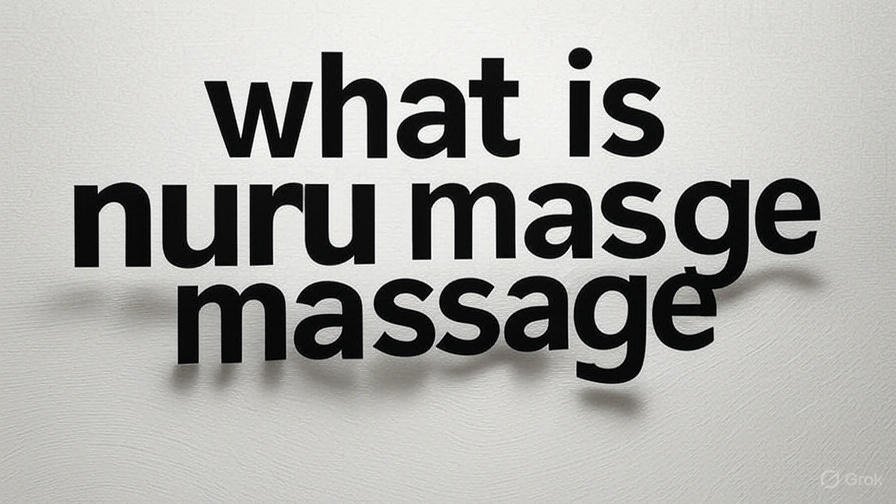A Growing Wellness Trend: What is Nuru Massage?
In 2025, the wellness industry is abuzz with innovative practices, and one that’s capturing global attention is Nuru massage. Originating from Japan, this unique form of bodywork combines sensory stimulation with deep relaxation, offering an experience unlike any other. But what is Nuru massage, and why is it becoming a cornerstone of modern wellness? This news article explores its cultural roots, distinctive techniques, and what makes it stand out in today’s spa landscape.
With its slippery gel and full-body techniques, Nuru massage is redefining relaxation for wellness enthusiasts worldwide, from Tokyo to New York.
The Cultural and Historical Roots of Nuru Massage
Nuru massage traces its origins to Kawasaki, Japan, where it emerged in the 1970s within the country’s bathhouse culture. The word “Nuru,” meaning “slippery” in Japanese, refers to the signature gel used in this practice, derived from nori seaweed. According to wellness historian Dr. Hiroshi Tanaka, “Nuru massage was developed to provide a luxurious, intimate experience, blending physical relaxation with sensory connection in a way that was revolutionary for its time.”
Unlike ancient massage forms like Ayurveda or Shiatsu, Nuru massage is a modern innovation, initially popularized in Japan’s urban bathhouses. Its focus on creating a seamless, gliding experience has since made it a global phenomenon, offered in high-end spas across North America, Europe, and Australia. The practice reflects Japan’s cultural emphasis on mindfulness and connection, adapted for a contemporary wellness audience.
Unique Techniques of Nuru Massage
The defining feature of Nuru massage is its use of a specialized, seaweed-based gel that creates an ultra-smooth, slippery surface. This gel, typically made from nori seaweed, aloe vera, and chamomile, is hypoallergenic, odorless, and skin-friendly, ensuring a safe and luxurious experience. “The gel’s unique texture allows for fluid, whole-body movements that are both relaxing and invigorating,” says licensed massage therapist Sarah Kim, who specializes in holistic bodywork.
Unlike traditional massages that focus on specific muscle groups, Nuru massage involves full-body contact, with practitioners using their arms, torso, and legs to perform long, flowing strokes. Sessions often take place on a waterproof surface, such as an inflatable mat, to accommodate the gel’s slick nature. The environment is carefully curated—warm, dimly lit, and accompanied by soothing music—to enhance relaxation.
- Full-Body Contact: Practitioners use their entire body to create a seamless, gliding motion.
- Nuru Gel: A natural, hydrating gel that reduces friction and nourishes the skin.
- Immersive Setting: Warm temperatures and calming ambiance amplify the sensory experience.
How Nuru Massage Differs from Other Styles
Nuru massage stands apart from other massage styles like Swedish or deep tissue due to its holistic and sensory focus. While Swedish massage emphasizes muscle kneading and deep tissue targets tension relief, Nuru massage prioritizes full-body connection and relaxation. The slippery gel and body-to-body techniques create a sensation of weightlessness, which clients describe as uniquely soothing.
Another key distinction is the setting. Traditional massages typically occur on a padded table, while Nuru massage uses a waterproof surface to accommodate the gel’s fluidity. This allows for greater freedom of movement, making the experience feel more dynamic and immersive. The gel’s hydrating properties also provide skincare benefits, leaving the skin soft and moisturized—a bonus not found in most other massage styles.
For a deeper dive into massage comparisons, check out our guide on Types of Massage Therapies.
Why Nuru Massage is Making Headlines in 2025
The rise of Nuru massage reflects a broader shift toward experiential wellness practices. Spas in major cities like London, Los Angeles, and Sydney are reporting increased demand, driven by social media and wellness influencers showcasing its luxurious appeal. A 2025 report from the Global Wellness Institute notes that sensory-focused therapies like Nuru massage are growing by 12% annually, as clients seek novel ways to de-stress.
However, its intimate nature has sparked discussions about professionalism and ethics. Reputable spas prioritize clear boundaries, informed consent, and trained practitioners to ensure a safe experience. “Choosing a licensed provider with positive reviews is essential,” advises Kim. The American Massage Therapy Association emphasizes the importance of selecting certified professionals for any massage therapy, including specialized practices like Nuru. For those interested, researching establishments with a strong reputation is key to a comfortable session.
Is Nuru Massage Right for You?
Nuru massage is ideal for those open to a unique, sensory-driven wellness experience. Its blend of physical relaxation and emotional connection appeals to spa-goers seeking something beyond traditional treatments. However, its intimate nature requires comfort with close contact, and clear communication with the practitioner is crucial.
As wellness trends evolve, Nuru massage is cementing its place as a luxurious, holistic practice. Whether you’re a wellness enthusiast or simply curious, understanding its origins and techniques can help you decide if it’s the right addition to your self-care routine.
Ready to explore wellness trends? Discover more at Global Wellness News.
You may also read: Decoding NFS: What Does NFS Mean in Texting and Social Media?
